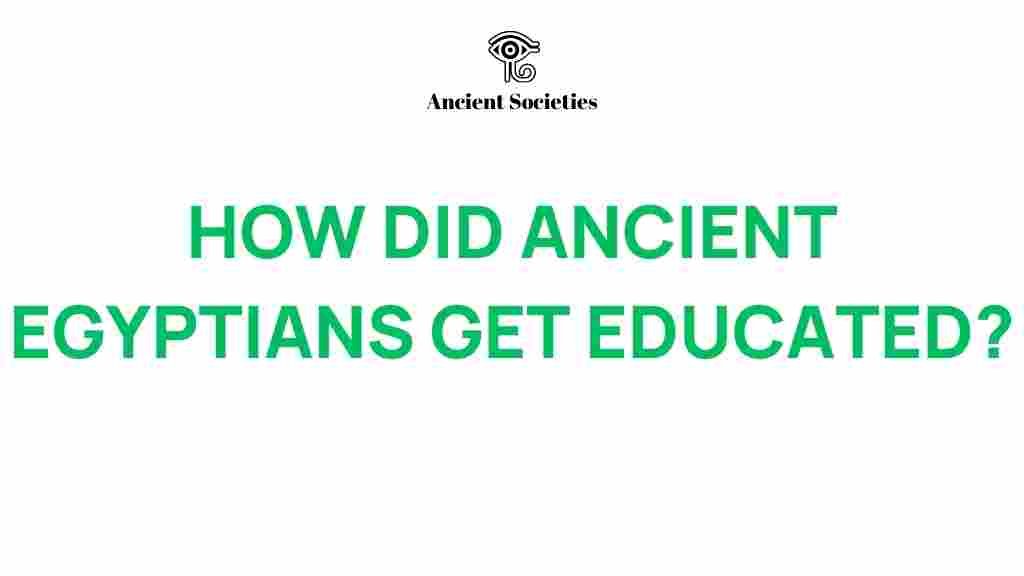Unveiling the Secrets of Ancient Egyptian Education
The culture of Ancient Egypt is one of the most fascinating and enduring legacies of human civilization. Among its many remarkable aspects, the education system of Ancient Egypt stands out as a significant contributor to its advanced society. This article explores the education system in Ancient Egypt, focusing on how knowledge was transmitted through hieroglyphs, the role of scribes, and the impact of the Nile on educational practices.
The Foundation of Ancient Egyptian Education
Education in Ancient Egypt was a critical component of society, aimed primarily at preparing young boys for their future roles as scribes, priests, or government officials. The focus was largely on practical skills, literacy, and the transmission of cultural knowledge.
- Hieroglyphs: The written language of Ancient Egypt, which consisted of pictorial symbols, was a fundamental part of education.
- Scribes: These were highly respected individuals who were trained in reading and writing hieroglyphs, making them essential to the administration and culture of Ancient Egypt.
- Cultural Transmission: Education also involved teaching religious texts, mathematics, and astronomy, which were all essential to the functioning of society.
The Role of the Nile in Education
The Nile River was the lifeblood of Ancient Egypt, and its annual floods provided fertile land for agriculture. This agricultural abundance allowed for a more stable society, which in turn supported the growth of education. The availability of resources meant that families could afford to send their children to schools, particularly the sons, who were often groomed for roles in administration.
Structure of Ancient Egyptian Schools
Schools in Ancient Egypt were primarily focused on boys, as formal education for girls was limited. The schools were often attached to temples or royal palaces, where the most knowledgeable priests or officials served as educators.
- Types of Schools:
- Temple Schools: Focused on religious education and training for priests.
- Writing Schools: Specialized in teaching hieroglyphs and administrative skills.
- Household Schools: Informal education that occurred within wealthier families.
Curriculum and Subjects Taught
The curriculum in Ancient Egyptian schools was comprehensive, aimed at instilling both practical skills and cultural knowledge. The subjects included:
- Hieroglyphs and Writing: Mastery of hieroglyphs was essential for anyone aspiring to become a scribe.
- Mathematics: Basic arithmetic was taught, particularly for administrative purposes.
- Religious Texts: Students learned sacred texts, which were crucial for their roles in society.
- Medicine and Science: Knowledge in these areas was also imparted, reflecting the advanced understanding of health and the universe.
The Path to Literacy
Achieving literacy in Ancient Egypt was a rigorous process. Young boys would start learning at a very young age, often around the age of five. The path to literacy involved:
- Repetition: Students would practice writing hieroglyphs repeatedly.
- Memorization: Much of the learning was based on memorizing texts and procedures.
- Practical Application: Students would apply their knowledge in real-world scenarios, such as record-keeping and administration.
Challenges in Ancient Egyptian Education
While the education system in Ancient Egypt was advanced for its time, it was not without its challenges:
- Access to Education: Education was primarily reserved for the elite, limiting opportunities for lower-class children.
- Limited Curriculum for Girls: Girls received little formal education, which restricted their roles in society.
- Geographical Barriers: The vastness of Ancient Egypt and the reliance on the Nile for transport meant that access to schools could be challenging for some families.
Influence of Religion on Education
Religion played a crucial role in education in Ancient Egypt. The education system was heavily influenced by the beliefs and practices of the time. Key elements included:
- Priestly Education: Many students were trained to become priests, learning sacred texts and rituals.
- Ethical Teachings: Moral lessons were taught alongside academic subjects, embedding a sense of ethics in students.
- Literary Works: Students studied religious literature and poetry, which were integral to their cultural identity.
The Scribe: A Key Figure in Ancient Egyptian Society
Scribes were the backbone of the educational system and played a vital role in Ancient Egyptian society. Their responsibilities included:
- Record Keeping: Scribes maintained records for the government, religious institutions, and businesses.
- Tax Collection: They were essential in documenting and collecting taxes, which were necessary for the state’s economy.
- Cultural Preservation: Scribes preserved knowledge and culture by copying texts and maintaining libraries.
Legacy of Ancient Egyptian Education
The education system of Ancient Egypt laid the groundwork for future generations. Its emphasis on literacy, record-keeping, and the preservation of knowledge influenced subsequent cultures and civilizations. Today, the remnants of this knowledge can still be seen in:
- Hieroglyphs: The study of hieroglyphs continues to provide insights into Ancient Egyptian culture and language.
- Historical Texts: Many texts from this era have survived, allowing historians to understand the education and culture of Ancient Egypt.
- Modern Education Systems: Elements of the Ancient Egyptian system can be seen in various educational systems today, especially in the emphasis on written language and record-keeping.
Conclusion
In conclusion, the education system of Ancient Egypt was a complex and integral part of its culture. Through the study of hieroglyphs and the training of scribes, knowledge was preserved and transmitted across generations. The influence of the Nile, the role of religion, and the structured educational paths all contributed to a society that valued literacy and cultural continuity. Understanding Ancient Egyptian education not only unveils the secrets of a remarkable civilization but also highlights the importance of knowledge in shaping human history.
For more insights into the fascinating world of Ancient Egypt, check out this resource. If you’re interested in learning more about hieroglyphs and their significance, visit this page.
This article is in the category History and created by AncientSocieties Team

3 thoughts on “Unveiling the Secrets of Ancient Egyptian Education”